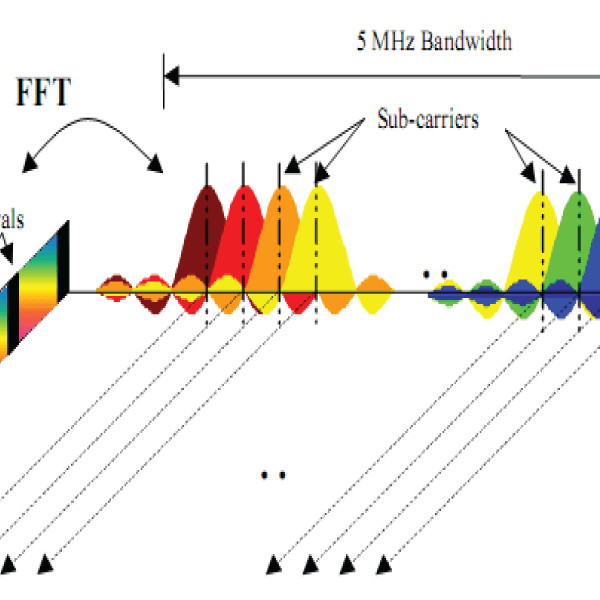Description
Low-Density Parity-Check And 256 Qam Of New Radio (Nr) Technology Based Data Detection Scheme? For 5G Communication System
ABSTRACT
In this paper, the low-density parity-check code and 256 QAM of new radio (NR) technology were applied to meet the high reliability and high data-rate requirements of 5G communications systems. In addition, we propose a data detection scheme based on a log-likelihood ratio (LLR) at the bit level to improve the reliability. The simulation results show that the proposed data detection scheme can improve the error rate and throughput of a conventional system. As a channel-coding scheme, LDPC channel coding is applied instead of turbo coding used in 4G LTE. As the modulation, 256 QAM is applied instead of 64 QAM. Low-Density Parity-Check And 256 Qam Of New Radio (Nr) Technology Based Data Detection Scheme? For 5G Communication System
INTRODUCTION
Currently, 5th-generation (5G) mobile systems are being developed following the Long Term Evolution (LTE) and LTE-Advanced systems. The requirements for 5G include improvements in the data rates, increases in the system capacity, much lower latency, and much higher connectivity density (such as internet of things; IoT). The primary reason for pursuing the development of 5G systems is that the amount of mobile data traffic is expected to reach levels 1,000 times higher by the year 2020 when compared to traffic levels in 2010. In order to improve data rates, a straight forward means is the use of higher-order modulation, which can increase the data rate within a given bandwidth. In LTE and LTE Advanced systems, quadrature phase shift keying (QPSK), 16- quadrature amplitude modulation (QAM), and 64-QAM are being used for the symbol modulation of orthogonal frequency division multiplexing (OFDM). Furthermore, 256-QAM entry has been recently discussed mainly in the 3rd Generation Partnership Project (3GPP). The maximum bandwidth utilization of 256-QAM is in principle eight times that of QPSK, although the higher-order modulation scheme is at the cost of robustness to noise and interference. However, the combination of channel coding and the higher-order modulation, i.e., modulation and coding scheme (MCS), will be more efficient additionally, countless use cases with a wide variety of applications will need to be supported.
EXISTING SYSTEM
- Heterogeneous network (HetNet) and small cell enhancement (SCE) approach is to deploy a denser infrastructure that includes support by a low-power evolved Node B (eNB).
- Three-dimensional (3D) beamforming has been also considered for enhancing system performance, which can adapt the antenna beam individually for each user equipment (UE) in the elevation domain, i.e., UE-specific elevation beamforming.
DISADVANTAGES
- The cell radius covered by a small cell will be short; therefore, it is expected that such a small cell environment could mitigate the fading impact.
- The use of HetNet, SCE, and 3D beamforming and so on enhances the introduction of a higher-order modulation scheme, since these technologies can increase the received SINR. Previously, we proposed a OFDM-based 256-, 1024-, and 4096-QAM and demonstrated the fundamental transmission performance under static propagation condition. However, there are uncertainties in the robustness against the multipath fading propagation conditions.
PROPOSED SYSTEM
As a channel-coding scheme, LDPC channel coding is applied instead of turbo coding used in 4G LTE. As the modulation, 256 QAM is applied instead of 64 QAM. The use of higher-order modulation is an important approach for increasing data rates within a limited bandwidth. In this paper, we demonstrate the performance of the orthogonal frequency division multiplexing (OFDM)-based 256-QAM. we propose a data detection scheme based on a log-likelihood ratio (LLR) at the bit level to improve the reliability. The simulation results show that the proposed data detection scheme can improve the error rate and throughput of a conventional system.
APPLICATIONS
The millimeter-wave supports wide bandwidth, and its short wavelength of it enables the miniaturization of antennas. Therefore, millimeter-wave-based mobile communication systems can be equipped with more antennas in the same space as long-term evolution (LTE) base stations. However, short wavelengths can cause high path loss and low signal-to-noise ratio (SNR)
BLOCK DIAGRAM EXPLANATION
A block diagram of the OFDM-based transmission model consisting of a single branch. The channel between the transmitter and receiver is modeled by a typical additive white Gaussian noise (AWGN) and multipath fading channel. At the transmitter side, the baseband signals are encoded by turbo coding. The encoded signals are mapped to 256- or 1024-QAM by symbol modulation. OFDM modulation computes the inverse fast Fourier transform (IFFT) of the input QAM signals. Finally, cyclic-prefix insertion is used as a typical OFDM transmission. On the receiver side, first the cyclic-prefix is removed. Then, OFDM demodulation computes the fast Fourier transform (FFT) of the received signals to separate each subcarrier component that is then de-mapped to QAM. Each component signal is demodulated by symbol demodulation. After Viterbi decoding, the original baseband signals are detected.
SOFTWARE REQUIRED
MATLAB 2018 and above
REFERENCE
[1] A. Gupta, R.K. Jha, ?Power optimization using massive MIMO and small cells approach in different deployment scenarios?, Wireless Networks, Vol. 23(3), pp. 959-973, 2017.
[2] I. biag and V. joeti ?PAPR reductions in OFDM systems?, second International conferences on computational intelligence, communication systems and networks, pp 373-377, July 2010.
[3] Hyusnsoo kim, jonghyun bang, sooyong and Daesik Hong, ?Resource block management for uplink UFMC systems?, IEEE, 2016.
[4] Sathiyapriya N.S, ?Implementation and study of Universal Filtered Multicarrier Frequency offset for 5G?, International Journal of Electronics and Communication (IIJEC), vol. 4, issue 4, pp. 1-5.
[5] Changyoung An, Byeongjae Kim and Heung Gyoon Ryu, ?Waveform comparison and non-linearity sensitivities of UFMC and W- OFDM sytem?, CS & IT- CSCP 2016, pp. 83-90, 2016.
[6] Jae Hong Lee and Seung Hee Han, ?An overview of peak to average power ratio reduction techniques for multi carrier transmission system?, IEEE wireless communication systems, pp. 56-65, April 2005.
[7] Ravi Teja kamurthi and Shakti Raj Chopra, ?review of UFMC technique in 5G?, ICICS conference-2018, IEEE transactions, 2018.
[8] S. R. Chopra, A. Gupta and H. Monga, “An LTE Approach with MIMO by Using Suboptimal Selection of Antenna,” 2018 International Conference on Intelligent Circuits and Systems (ICICS), Phagwara, pp. 167-172, 2018.
[9] R. Kausar, A. Gupta, I. B. Sofi and K. Arora, “Bit Error Rate Based Performance Evaluation of LTE OFDMA System,” 2018 International Conference on Intelligent Circuits and Systems (ICICS), Phagwara, pp. 161-166, 2018.
[10] A. Gupta, S. Dogra, I. B. Sofi, ?Performance Evaluation of Spatial Multiplexing Using Different Modulation Techniques in MIMO System for Small and Large Scale Fading Channel?, International Journal of Sensors Wireless Communications and Control, Vol. 9(2), pp. 188-202, 2019.



































































































































































































































































































































































































































































































































































































































































































































































































































































































































































































































































Customer Reviews
There are no reviews yet.